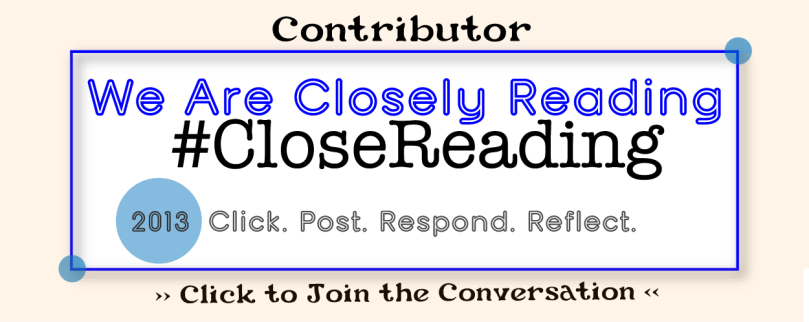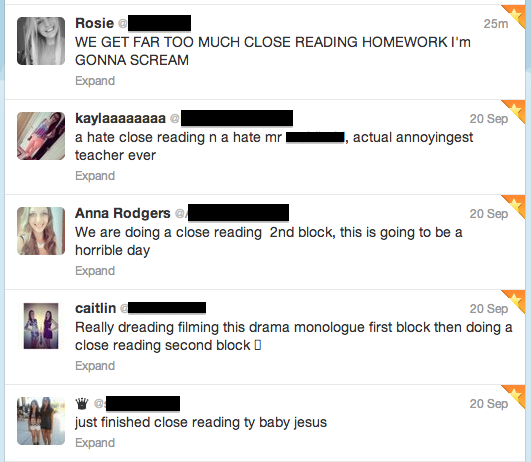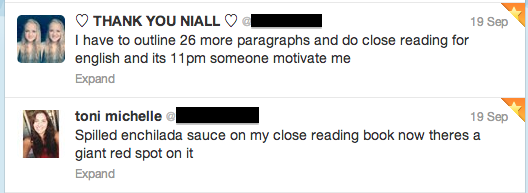Only two weeks left in our 7-week blog-a-thon on #closereading! It has been an exciting, inspiring conversation. Be sure to read the Contributors page and consider linking to your own post.
Also, heads up that my “Fall in Love with Close Reading” workshop in Brookfield, WI on December 6 is nearly sold out. Seats are also going quickly for the date Kate and I will be together in Amherst, NY on December 9. We look forward to learning with you in person!
When You Stop Making Sense
Katie Wood Ray and Lester Laminack have one of the greatest titles for a professional education book: “The Writing Workshop: Working Through the Hard Parts (And They’re All Hard Parts)” (2001 NCTE). It feels as if you could swap out “the writing workshop” for nearly anything in education and the title still holds: Social Studies: … And They’re All Hard Parts. Parent Involvement: … And They’re All Hard Parts. Grading…. And They’re All Hard Parts. And for our purposes here: Close Reading… And They’re All Hard Parts!
The good news is, as their title suggests, there are challenges in everything and yet you can work through them.
Case in point: teaching students to read closely to consider structure.
Now, perhaps you have long since mastered this instructional skill set. If you have, we would love you to link to a post about it. But let me tell you, Kate and I found this probably one of the biggest challenges in our study of close reading. It snuck up on us. Because on the outset it seems so simple, just stand in front of a class of students and begin your lesson with a crystal clear analogy:

“Structure in books is a lot like the frame of a house or like the beams in a building. With that structure in place an architect can then attach everything else to it. It is what makes that building solid and whole. It is what gives that building it’s shape. Without structure, the building would fall apart.
…so.
….um.
….read to notice. that. stuff.
…now.”
It was not as simple as we thought.
Now, while many of our early attempts did not sound this pathetic, they often times felt pretty close. In one triumphant instance I was working with a class of sixth graders while the entire sixth grade team of teachers sat in. I modeled with a simple picture book (you know, so it would be quick and clear) and ended up taking nearly 30 minutes of talking and scribbling all over the board to demonstrate considering the structural choices the author made in the text.
At the very end I felt somewhat okay with myself, despite the absurdly long time. I mean, the board was full of lines and arrows and bullets. Clearly it was thought-provoking. Then, one teacher said, “Wait, so we’re just trying to make a timeline of all of the scenes?” I stepped back and realized that was exactly what I did. Only in a dramatic, overly complicated, way.
I felt ridiculous.
Instruction Is Not About “Perfect,” It’s About “Responsive”
If not for seeing what didn’t work, we never would have gotten to what worked (or, at least, what worked a lot better). What matters in close reading instruction, all instruction for that matter, is that we are willing to make an attempt and even more willing to look for parts of our instruction to revise.
Several actions helped us during this process of revising our teaching:
- Always returning to student work to look for evidence of (or lack of) independence. If we didn’t see it, we knew our teaching wasn’t clear enough or transferable.
- Looking for approximation and then building on that strength, both in student attempts and our own. A “are we there yet?” way of looking at our teaching choices helped us keep moving forward.
- Lots of professional, reflective conversation. In their book, Professional Capital, Michael Fullan and Andy Hargreaves argue that a large piece of improving education revolves around making more time for collaboration. They point out that great schools do not have stellar teaching in random classrooms, but instead teams that grow, think, and plan together. We found each conversation, with whomever was willing to talk and reflect with us, to be hugely instructive.
Each attempt got better. Each time we were surprised by what we learned.
For instance, we began to see that structure didn’t just fall into one category but several. That sometimes structural choices are the major parts of a text–like scenes in a novel or video game, or sections in an article. That sometimes authors structured where and how techniques were used–like repeating a particular line in a poem, the appearance and reappearance of a certain color in a movie.
We found that for some students rereading to consider structural choices was naturally more of a two-step process: first they would locate the parts, then they would return to consider the purposes for that organization.
Then, of course, were times students blew our minds. In the chapter on structure in our book we include a few images from a high school class in which students not just thought about the purposes of structure in the text, but then experimented with ways of diagraming them.
Each new avenue started with a not-so-hot attempt.
It Will Be Challenging And You’ll Love It

There will be times when your work with close reading goes amazingly well. Then, there will be times went it flops. When things fall apart we first send a heartfelt hug from across the miles–we’ve been there, friend–and we also want to say how exciting moments like those become.
Think of each interaction with your students as a chance to learn, a chance to follow the lead of your students, to study alongside your colleagues. With that mindset, there are no failures, only new understandings.
Your Turn
What have been your biggest challenges in close reading instruction? What have been your biggest moments of learning? Comment on this post, or better yet add a link to your own blog post. See the Contributor Page for more ideas and inspiration from fellow educators.
Share your insights, we are closely reading close reading together!
Look for Kate’s blog-a-thon Post 12 on Thursday!











